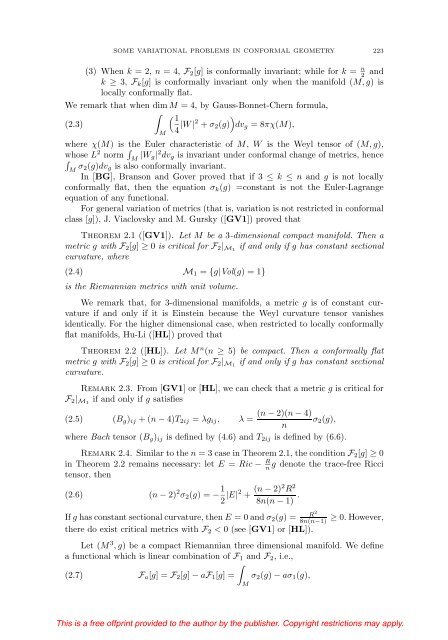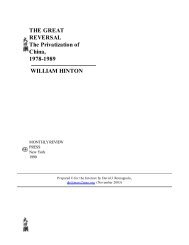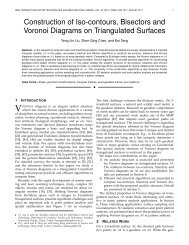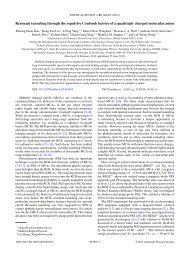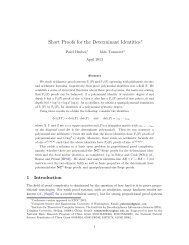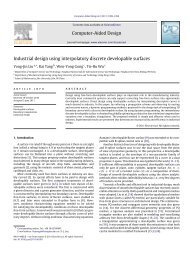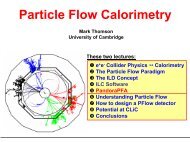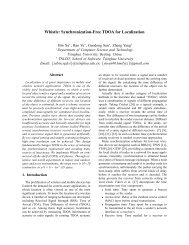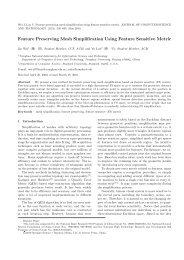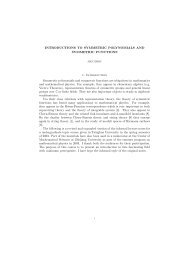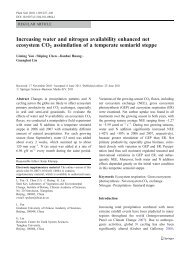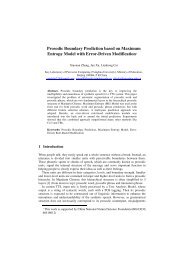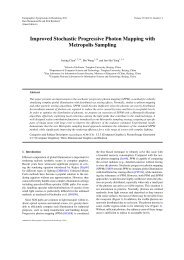Some variational problems in conformal geometry
Some variational problems in conformal geometry
Some variational problems in conformal geometry
You also want an ePaper? Increase the reach of your titles
YUMPU automatically turns print PDFs into web optimized ePapers that Google loves.
SOME VARIATIONAL PROBLEMS IN CONFORMAL GEOMETRY 223<br />
(3) When k =2,n =4,F 2 [g] is <strong>conformal</strong>ly <strong>in</strong>variant; while for k = n 2 and<br />
k ≥ 3, F k [g] is <strong>conformal</strong>ly <strong>in</strong>variant only when the manifold (M,g) is<br />
locally <strong>conformal</strong>ly flat.<br />
We remark that when dim M = 4, by Gauss-Bonnet-Chern formula,<br />
∫ ( 1<br />
(2.3)<br />
4 |W |2 + σ 2 (g))<br />
dv g =8πχ(M),<br />
M<br />
where χ(M) is the Euler characteristic of M, W is the Weyl tensor of (M,g),<br />
whose L 2 norm ∫ ∫<br />
M |W g| 2 dv g is <strong>in</strong>variant under <strong>conformal</strong> change of metrics, hence<br />
M σ 2(g)dv g is also <strong>conformal</strong>ly <strong>in</strong>variant.<br />
In [BG], Branson and Gover proved that if 3 ≤ k ≤ n and g is not locally<br />
<strong>conformal</strong>ly flat, then the equation σ k (g) =constant is not the Euler-Lagrange<br />
equation of any functional.<br />
For general variation of metrics (that is, variation is not restricted <strong>in</strong> <strong>conformal</strong><br />
class [g]), J. Viaclovsky and M. Gursky ([GV1]) proved that<br />
Theorem 2.1 ([GV1]). Let M be a 3-dimensional compact manifold. Then a<br />
metric g with F 2 [g] ≥ 0 is critical for F 2 | M1 if and only if g has constant sectional<br />
curvature, where<br />
(2.4) M 1 = {g|Vol(g) =1}<br />
is the Riemannian metrics with unit volume.<br />
We remark that, for 3-dimensional manifolds, a metric g is of constant curvature<br />
if and only if it is E<strong>in</strong>ste<strong>in</strong> because the Weyl curvature tensor vanishes<br />
identically. For the higher dimensional case, when restricted to locally <strong>conformal</strong>ly<br />
flat manifolds, Hu-Li ([HL]) proved that<br />
Theorem 2.2 ([HL]). Let M n (n ≥ 5) be compact. Then a <strong>conformal</strong>ly flat<br />
metric g with F 2 [g] ≥ 0 is critical for F 2 | M1 if and only if g has constant sectional<br />
curvature.<br />
Remark 2.3. From [GV1] or[HL], we can check that a metric g is critical for<br />
F 2 | M1 if and only if g satisfies<br />
(n − 2)(n − 4)<br />
(2.5) (B g ) ij +(n − 4)T 2ij = λg ij , λ = σ 2 (g),<br />
n<br />
where Bach tensor (B g ) ij is def<strong>in</strong>ed by (4.6) and T 2ij is def<strong>in</strong>ed by (6.6).<br />
Remark 2.4. Similar to the n = 3 case <strong>in</strong> Theorem 2.1, the condition F 2 [g] ≥ 0<br />
<strong>in</strong> Theorem 2.2 rema<strong>in</strong>s necessary: let E = Ric − R n<br />
g denote the trace-free Ricci<br />
tensor, then<br />
(2.6) (n − 2) 2 σ 2 (g) =− 1 2 |E|2 + (n − 2)2 R 2<br />
8n(n − 1) .<br />
If g has constant sectional curvature, then E =0andσ 2 (g) =<br />
R2<br />
8n(n−1)<br />
≥ 0. However,<br />
there do exist critical metrics with F 2 < 0(see[GV1] or[HL]).<br />
Let (M 3 ,g) be a compact Riemannian three dimensional manifold. We def<strong>in</strong>e<br />
a functional which is l<strong>in</strong>ear comb<strong>in</strong>ation of F 1 and F 2 , i.e.,<br />
∫<br />
(2.7) F a [g] =F 2 [g] − aF 1 [g] = σ 2 (g) − aσ 1 (g),<br />
M<br />
This is a free offpr<strong>in</strong>t provided to the author by the publisher. Copyright restrictions may apply.


